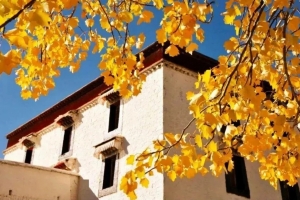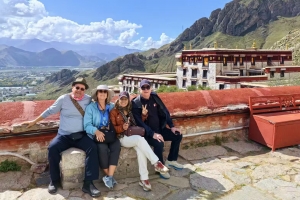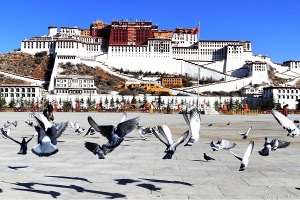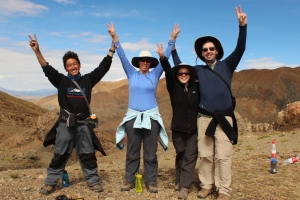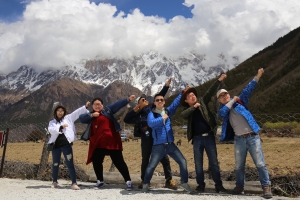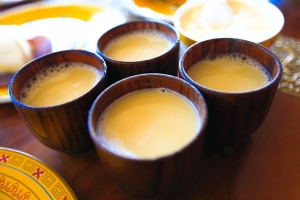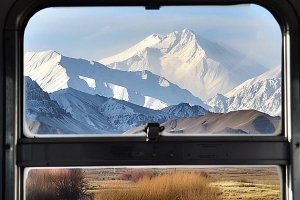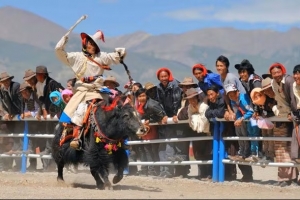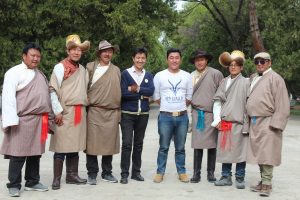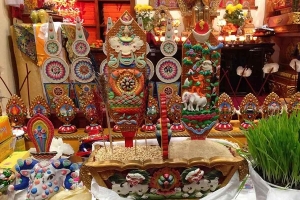Known in Tibetan as Nor, meaning “wealth” or “treasure,” Tibetan Yak is not merely livestock. It is a symbol of survival, spirituality, and abundance, woven into the daily rhythm of Tibetan existence for thousands of years. In Tibetan folklore, the yak is revered as a totem of strength and protection, a guardian of the nomadic clans. Even today, when you travel across the grasslands of Tibet, you’ll see yaks grazing peacefully under the vast blue sky – a scene so timeless and tranquil that it feels like the land itself is breathing through them.
The Cultural and Spiritual Significance of Yaks
For Tibetan people, the yak is far more than an animal. It is a bridge between humans and nature, a sacred companion, and a symbol of divine generosity. Every part of the yak serves a purpose, ensuring that nothing is wasted.
Yaks as Sacred Beings
In many Tibetan monasteries, you will find yak butter lamps flickering before sacred images of the Buddha. The butter that fuels these eternal flames is made from yak milk — a humble offering representing light, wisdom, and devotion. It’s said that the purer the butter, the brighter the light, guiding souls toward enlightenment.
During major Tibetan festivals such as Losar (New Year) or Saga Dawa (the festival honoring Buddha’s birth, enlightenment, and death), yak butter sculptures called Torma are crafted as artistic tributes to the gods. These intricate designs — some in the shapes of flowers, temples, or mythical beasts — show not only Tibetans’ deep reverence for yaks but also their spiritual creativity.
The Totem of Strength and Endurance
The yak’s ability to endure extreme cold, harsh winds, and thin air has made it a symbol of resilience. In Tibetan proverbs, “as strong as a yak” is the highest compliment to a person’s endurance and courage. For nomadic families who rely on nature’s mercy, the yak embodies the strength to survive and thrive in adversity — a trait deeply admired in Tibetan society.
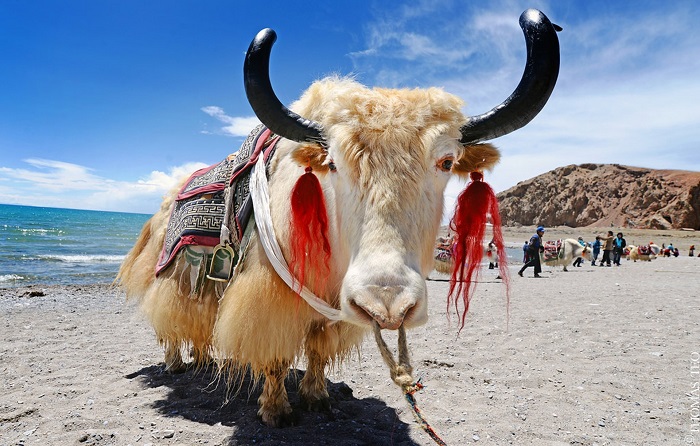
Yaks and Tibetan Daily Life
Clothing: The Gift of Warmth
A yak’s thick, soft undercoat — especially from the long-haired Tibetan breed — is spun into warm wool that can be woven into robes, blankets, tents, and even carpets. Tibetan herders use hand-spun yak hair to make Pulu, a dense woolen fabric ideal for coats and bedding.
Yak hair tents, dark and sturdy, are another traditional treasure. They are windproof, waterproof, and naturally insulating, keeping families warm in winter and cool in summer. If you visit a nomadic camp, you might be invited inside such a tent — smoky with butter tea aroma, dimly lit by butter lamps, and filled with the unmistakable coziness of yak hair warmth.
The hide of the yak is equally valuable. Its durability makes it perfect for crafting boots, belts, and leather bags. Some hides are dyed crimson or brown and polished into a glossy finish, used in Tibetan boots and decorative horse saddles — practical yet beautiful symbols of Tibetan craftsmanship.
Food: The Nourishment of Life
For Tibetans, yak milk is both sustenance and luxury. A single female yak can produce several kilograms of milk per day — thicker, richer, and more nutritious than cow’s milk. From this milk come some of Tibet’s most iconic foods:
- Yak Butter (Ghee) – The foundation of Tibetan cuisine. Used in butter tea, fried snacks, and temple lamps.
- Yogurt and Cheese – Locally fermented and sun-dried into chewy snacks that travelers and herders love.
- Tsampa with Yak Butter Tea – A staple meal combining roasted barley flour, butter, and tea — warm, filling, and perfectly suited to high-altitude life.
Tibetans also believe yak butter has spiritual power — used in offerings, healing, and religious rituals. During long winter nights, its aroma fills the air as butter lamps burn before family altars.
And for meat, yak provides rich, lean protein — vital for survival in regions where vegetables are scarce. Yak jerky, preserved through air-drying, can last months and sustain nomads on long journeys.
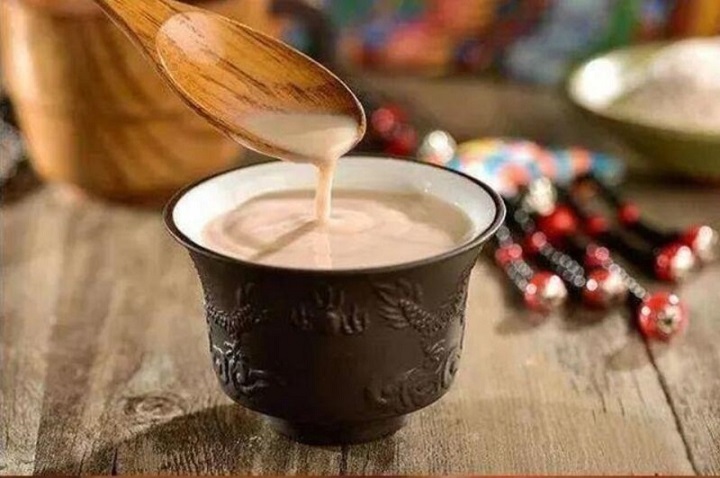
Yak Milk
Shelter: The Black Tent of the Plateau
If you travel across the grasslands of Nagqu or Shigatse, you’ll notice black yak-hair tents dotting the horizon. These traditional dwellings are masterpieces of nomadic engineering.
The tents are woven from twisted yak hair ropes and stitched together into panels. When the rain pours, the hair fibers swell and become waterproof; when the sun shines, the fibers loosen to allow ventilation. Warm in winter, cool in summer, and portable all year round, the yak-hair tent perfectly mirrors the adaptability of the Tibetan people.
It’s not only a home but also a symbol of freedom — wherever the herders go, their homes follow, carried by their loyal yaks.
Transportation: The Plateau’s Living Vehicle
Long before modern roads and trucks reached Tibet, the yak was the only reliable transporter. Whether hauling barley harvests or carrying sacred statues to monasteries, yaks were — and still are — the lifeblood of Tibetan movement.
Their strength is astonishing. A yak can carry 100 kilograms or more over steep mountain passes exceeding 5,000 meters, where few animals or even humans can breathe easily. They are “the ships of the plateau,” moving gracefully across treacherous terrain, rivers, and snowfields.
During annual pilgrimages to Mount Kailash and Lake Manasarovar, pilgrims depend on yak caravans to carry their luggage, tents, and even themselves when exhaustion sets in. Watching a long line of yaks climb through clouds, bells jingling softly, is one of the most moving sights in Tibet — a dance of faith and endurance across the sky.
Fuel: The Sacred Flame of Yak Dung
In a treeless land where firewood is scarce, yak dung (known as “Jiuwa” in Tibetan) is the primary fuel for cooking and heating. Far from being seen as dirty, yak dung is a sacred and sustainable gift. It burns with steady heat and minimal smoke, keeping homes warm through brutal winters.
Even Tibetan medicine acknowledges its value. A traditional therapy called “Longdu” involves burning yak dung and inhaling the smoke, believed to calm the mind and ease certain ailments. It’s a fascinating reminder that even what others might discard holds sacred meaning in Tibetan culture.
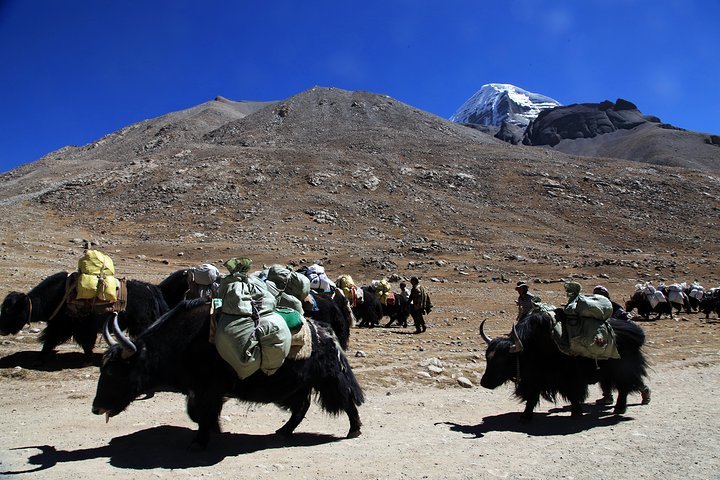
Yaks in Tibetan Festivals and Art
Yaks are central figures in Tibetan celebrations. During Shoton Festival in Lhasa, giant yak butter sculptures are displayed, while herders decorate their yaks with colorful tassels and bells during summer gatherings.
In Tibetan art, the yak often appears alongside mountains, clouds, and snow lions — representing power, purity, and endurance. Its image is woven into carpets, carved into temple murals, and sung about in folk songs. For Tibetans, to paint or sing about a yak is to praise life itself.
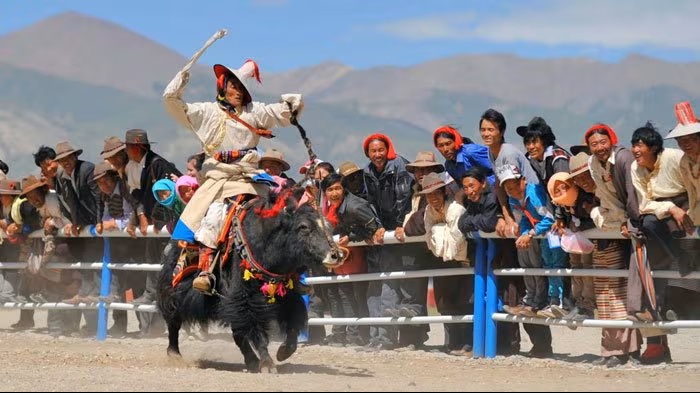
Yaks and Modern Tourism in Tibet
Today, the yak remains a beloved companion for both locals and travelers. When trekking around Mount Everest Base Camp, Namtso Lake, or Mount Kailash, visitors often rely on yak caravans to carry gear across high-altitude trails.
For photographers, the yak is a living emblem of Tibet’s spirit — sturdy, serene, and photogenic against the backdrop of snow mountains and turquoise lakes.
Some Tibetan families even welcome tourists to experience herding life, offering homestays where guests can help milk yaks, churn butter, and spin wool. Such experiences reveal the deep harmony between humans and animals on the plateau — a lesson in respect and coexistence.
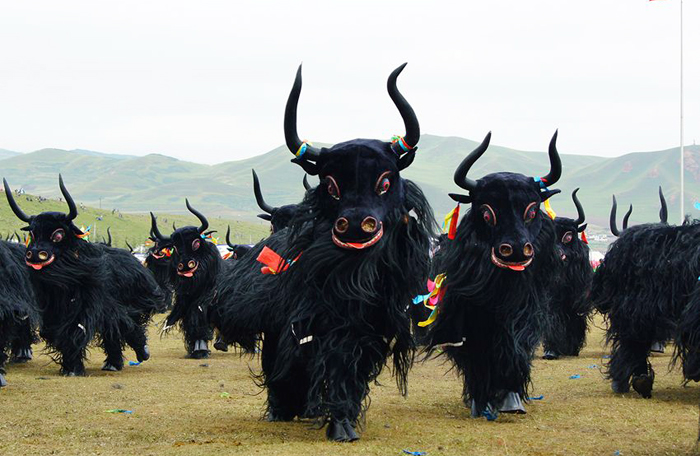
Why the Yak Symbolizes the Heart of Tibet
To understand Tibet, one must understand the yak. It represents life’s interdependence — how humans and nature sustain each other through balance, respect, and gratitude.
The yak has witnessed centuries of nomadic migration, prayers whispered under the Milky Way, and pilgrims’ footsteps around sacred mountains. It has provided the warmth, food, and strength that allowed Tibetan civilization to endure.
To Tibetans, the yak is not property — it is family, friend, and teacher. Its presence reminds every traveler that life on the plateau, though harsh, is also full of grace.
Journey2Tibet: Discover the Spirit of Yaks Yourself
If you wish to encounter these magnificent creatures up close, Journey2Tibet can take you there. Our local Tibetan guides will lead you to remote yak pastures, mountain valleys, and sacred lakes where yaks roam freely. You can photograph them, learn traditional yak-herding skills, and even enjoy authentic yak butter tea inside a nomad’s tent.
Whether you’re trekking near Mount Kailash or exploring the endless grasslands of Nagqu, standing beside a Tibetan yak feels like standing beside the soul of Tibet itself — strong, peaceful, and enduring.
Let the Journey2Tibet team craft your perfect Tibetan adventure — where every heartbeat of the land tells the story of the yak, the true spirit of the plateau.

